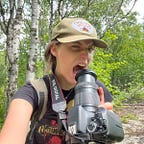How does Carson’s excerpt in “Silent Spring” demonstrate that figurative language important in emphasizing scientific facts?
With climate change–arguably one of the most pressing global issues of our time–being cast to the political backburner, it feels like now, more than ever, evocative language is necessary for conveying the immediacy of environmental injustices.
When the pioneers of environmental literature come to mind, of course, one is likely to think of writers like John Muir, and their encapsulating, yet persuasive, syntax that still inspires many environmentalists today. However, it goes without saying that the facts are the basis of bringing awareness to these pressing issues. Where some think that it’s time to ditch the colorful language and push the data, many still turn to expressive rhetoric in order to accurately paint the horrifying and realistic picture of our near-future in a world full of environmental injustice.
Taking a peek at today’s world of media and politics, it’s clear that extensively researched and established data regarding the topic is still not enough to convince many world leaders, corporations, and even some citizens to take action.
So, what takes hold?
What we observe throughout the history of environmental journalism, is that the most monumental pieces are able to utilize tools of figurative language to express the horrifying data. Rachel Carson’s renowned novel, “Silent Spring”, is one of the absolute examples of how to smother the reader in elements like personification, imagery, symbolism, metaphor, etc., while assertively denoting information on how life on earth is being slowly decimated.
At the beginning of the novel, Carson’s figurative language techniques force the reader to see the negative results of man-made poisons before force-feeding them facts. She reflects on a world without the impacts of mankind, a world where “all life seemed to be in harmony with its surroundings”, then quickly inserts a far different image to embed the topic of pesticides. Using language like “blight” and “evil” rather than the actual diction, like ‘pesticide’ or ‘chemicals’, Carson asserts the topic while invoking an emotional response (Carson, 1962). Instilling this sense of nostalgia, before the bombardment of petrifying truth, makes the principle much harsher for the reader.
It is methods like this that must not be forgotten. Not only did scientists and environmentalists delve into Silent Spring, but local book clubs, schools, and policymakers also began to flip through its pages. Eventually, citizens were not only aware of the detrimental effects of pesticides (like DDT), they were terrified. Thus, and finally, leaving one of the most harmful substances (DDT) to be outlawed.
When looking towards the future of environmental journalism, it is valid to ask where society would be now without works like Carson’s. A key takeaway from her piece is that emotion must be felt by the reader in order to provide meaning to the facts. In this case, and in nearly all cases of climate reporting today, emotions like shock and fear must be felt in the masses for world leaders to listen, and to create positive change. It is methods like hers that mustn’t be forgotten during the never-ending fight for climate activism.
